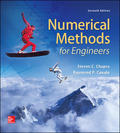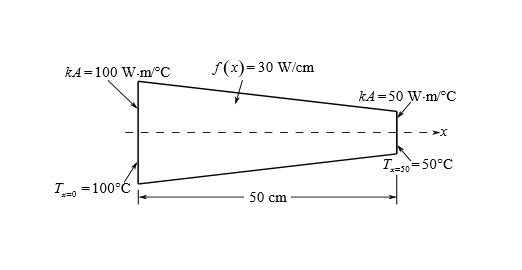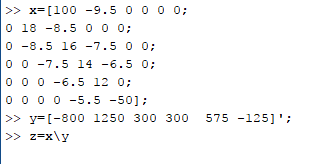
Concept explainers
To calculate: The temperature distribution in a rod as shown in figure below with internal heat generation using the finite-element method and also derive the element nodal equations using Fourier heat conduction.

Answer to Problem 12P
Solution: The temperature distribution in a rod at various nodes is shown below,

Explanation of Solution
Given Information:
To develop nodal equations for the temperature and their gradients at each of the six nodes. The element nodal equations is given as,
With the heat conservation relationships is,
Here,
The given rod is 50 cm long, the x-coordinate is positive to the right end and zero at the left end,
Calculation:
The element 1 the equations for the node 1 and node 2 is,
Solve the equation for node 1,
Substitute the value from given data,
Change the temperature so the equation becomes,
Solve the equation for the node 2,
Substitute the values from given data,
So, the equation of node 2 is,
Similarly, the value for other nodes is calculated. For element 2 at node 2,
Substitute the values from given data,
Change the state so the equation becomes,
Derive for node 3,
Substitute the values from given data,
So, the equation of node 3 is,
Derive the equation for the element 3,
Node 3
Substitute the values from given data,
Change the state so the equation becomes,
Derive for node 4,
Substitute the values from given data,
So, the equation of node 4 is,
Derive the equation for the element 4,
The equations for node 4 is,
Substitute the values from given data,
Change the state so the equation becomes,
Derive the equation for the node 5,
Substitute the values from given data,
So, the equation of node 5 is,
Derive the equation for the element 5,
For node 5,
Substitute the values from given data,
Change the state so the equation becomes,
Derive the equation for node 6,
Substitute the values from given data,
So, the equation of node 6 is,
The equation assembly is given as,
Insert the boundary conditions then the matrix becomes,
Use MATLAB to write code for solving the matrix,

The desired output is,

Want to see more full solutions like this?
Chapter 31 Solutions
EBK NUMERICAL METHODS FOR ENGINEERS
- 1. Evaluate the following improper integrals: (a) fe-rt dt; (b) fert dt; (c) fi da dxarrow_forward8. Given the rate of net investment I(t) = 9t¹/2, find the level of capital formation in (i) 16 years and (ii) between the 4th and the 8th years.arrow_forward9. If the marginal revenue function of a firm in the production of output is MR = 40 - 10q² where q is the level of output, and total revenue is 120 at 3 units of output, find the total revenue function. [Hints: TR = √ MRdq]arrow_forward
- 6. Solve the following first-order linear differential equations; if an initial condition is given, definitize the arbitrary constant: (a) 2 + 12y + 2et = 0, y(0) = /; (b) dy+y=tarrow_forward4. Let A = {a, b, c, d, e, f}, B = {e, f, g, h} and C = {a, e, h,i}. Let U = {a, b, c, d, e, f, g, h, i, j, k}. • Draw a Venn Diagram to describe the relationships between these sets Find (AB) NC • Find (AC) UB Find AUBUC • Find (BC) N (A - C)arrow_forward7. A consumer lives on an island where she produces two goods x and y according to the production possibility frontier x² + y² < 200 and she consumes all the goods. Her utility function is U(x, y) = x y³. She faces an environmental constraint on her total output of both goods. The environmental constraint is given by x + y ≤20. • (a) Write down the consumer's optimization problem. (b) Write out the Kuhn-Tucker first order conditions. (c) Find the consumer's optimal consumption bundle (x*, y*).arrow_forward
- 3. Answer the following questions: (a) Given the marginal propensity to import M'(Y) = 0.1 and the information that M = 20 when Y = 0, find the import function M(Y). (b) Given a continuous income stream at the constant rate of $1,000 per year, what will be the present value II if the income stream terminates after exactly 3 years and the discount rate is 0.04? (c) What is the present value of a perpetual cash flow of $2,460 per year, discounted at r = 8%?arrow_forward5. Let A and B be arbitrary sets. Prove AnB = AUB.arrow_forward2. Answer the following questions: (a) Given the marginal-revenue function R'(Q) = 28Q - €0.3Q, find the total-revenue function R(Q). What initial condition can you introduce to definitize the constant of integration? = (b) Given the marginal propensity to consume C'(Y) 0.80.1Y-1/2 and the information that C = Y when Y = 100, find the consumption function C(Y).arrow_forward
- 7. Let X, A, and B be arbitrary sets such that ACX and BC X. Prove AUB CX.arrow_forward1. Write out the following sets as a list of elements. If necessary you may use ... in your description. {x EZ: |x|< 10 A x < 0} {x ЄN: x ≤ 20 A x = 2y for some y = N} {n EN: 3 | n^ 1 < n < 20} {y Є Z: y² <0}arrow_forward3. For each statement below, write an equivalent statement using the justification given. = y Є A or yЄ B by the definition of union = y Є A or y Є B by the definition of set complement = x = C and x & D by DeMorgan's Law =Vx (x EnFxЄEUF) by definition of subset. = (X CYUZ)A (YUZ CX) by definition of set equalityarrow_forward
 Advanced Engineering MathematicsAdvanced MathISBN:9780470458365Author:Erwin KreyszigPublisher:Wiley, John & Sons, Incorporated
Advanced Engineering MathematicsAdvanced MathISBN:9780470458365Author:Erwin KreyszigPublisher:Wiley, John & Sons, Incorporated Numerical Methods for EngineersAdvanced MathISBN:9780073397924Author:Steven C. Chapra Dr., Raymond P. CanalePublisher:McGraw-Hill Education
Numerical Methods for EngineersAdvanced MathISBN:9780073397924Author:Steven C. Chapra Dr., Raymond P. CanalePublisher:McGraw-Hill Education Introductory Mathematics for Engineering Applicat...Advanced MathISBN:9781118141809Author:Nathan KlingbeilPublisher:WILEY
Introductory Mathematics for Engineering Applicat...Advanced MathISBN:9781118141809Author:Nathan KlingbeilPublisher:WILEY Mathematics For Machine TechnologyAdvanced MathISBN:9781337798310Author:Peterson, John.Publisher:Cengage Learning,
Mathematics For Machine TechnologyAdvanced MathISBN:9781337798310Author:Peterson, John.Publisher:Cengage Learning,






